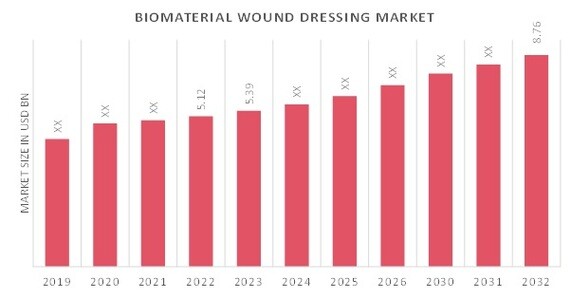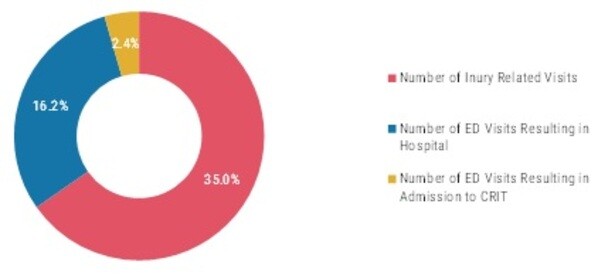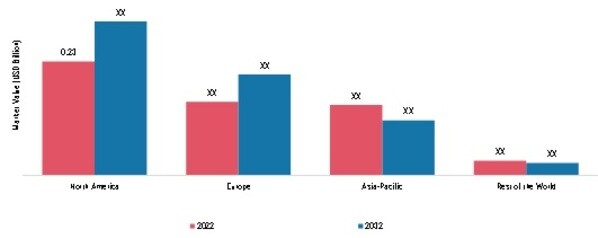Global Biomaterial Wound Dressing Market Overview
The Biomaterial Wound Dressing Market size was valued at USD 5.12 billion in 2022 and is projected to grow from USD 5.39 billion in 2023 to USD 8.76 billion by 2032, exhibiting a compound annual growth rate (CAGR) of 5.36% during the forecast period (2023 - 2032). The rising prevalence of chronic wounds such as diabetic ulcers, venous ulcers, and pressure ulcers, the increasing number of medical surgeries, such as cosmetic and orthopedic procedures, and rising demand for innovative wound dressing materials from the hospital and home care settings are driving the market growth.

Source: Secondary Research, Primary Research, MRFR Database and Analyst Review
Biomaterial Wound Dressing Market Trends
- The rising prevalence of chronic wounds such as diabetic ulcers, venous ulcers, and pressure ulcers boosts the market growth.
The rising prevalence of chronic wounds such as diabetic ulcers, venous ulcers, and pressure ulcers is greatly driving the market growth of the biomaterial wound dressing. According to a recent survey, the prevalence of diabetic foot ulcers is high in developed countries such as the United States, due to the rising number of people suffering from diabetes, and over 70% of them develop the symptoms associated with diabetic foot ulcers. As a result, the demand for better wound dressing materials such as hydrogels, foam, and alginates has increased considerably in the markets.
Furthermore, the rising government initiatives and consumer desire for quick and safe treatment of chronic wounds are further driving market expansion. For instance, over 537 million adults worldwide were living with diabetes in 2021, according to the IDF Diabetes Atlas' 10th edition from that organization. As a result, it is anticipated that the market under study will rise due to the rising number of persons with diabetes who are more prone to developing foot ulcers.
The level of medical equipment is also rising, according to a Polymers Journal article from April 2022, as a result of the rising demand for wound healing and wound care management. But for the purpose of dressing wounds, sutures continue to be the medical device of choice. As a result, there is a rising need for suture devices in North America since there is a rising need for surgeries connected to trauma and accident cases. In 2020, there were 40 visits to emergency departments (EDs) per 100 individuals. The rate of emergency department visits was highest for newborns under 1-year old (68 visits per 100 infants), next for individuals 75 and above (63 visits per 100 people).
Furthermore, in comparison to all other primary expected sources of payment, the CDC found that the rate of emergency department visits for patients with private insurance was lowest, while the rate for patients with Medicaid, the Children's Health Insurance Program, or other state-based programs was highest. Furthermore, according to the Centers for Disease Control and Prevention (CDC), there were 35 million emergency department visits for injuries, 16.2 million ED visits that resulted in hospital admissions, and 2.4 million ED visits that resulted in CRIT admissions. The numbers are provided below.
Figure 1: Number of Emergency Department (ED)Visits (in Million), United States, 2020

Source: Secondary Research, Primary Research, MRFR Database, and Analyst Review
Biomaterial Wound Dressing Market Segment Insights
Biomaterial Wound Dressing Type Insights
The market segments of Biomaterial Wound Dressing, based on type, includes hydrogel, alginate dressing, hydrocolloid dressings, skin substitutes, and others. The hydrogel sub segment is to held the majority share in 2022 Biomaterial Wound Dressing Market revenue. This is due to the widespread use of hydrocolloid-based wound dressings due to their high water retention capability and thermal stability. Moreover, hydrogel-based biomaterial wound dressings are a significant category within the wound care market. These dressings consist of a three-dimensional network of hydrophilic polymers that can absorb and retain water, creating a moist environment for wound healing.
September 2020: Acelity launched a new antimicrobial wound dressing called Prontosan Clear® CMC Wound Gel. This product is intended to be used for medium to heavily exuding wounds and has been designed to promote wound healing.
Biomaterial Wound Dressing Application Insights
The Biomaterial Wound Dressing Market segmentation is based on application, which includes burns, pressure ulcers, surgical wounds, lacerations and cuts, skin grafts and others. The surgical wounds segment has dominated the market in 2022 and is projected to be the fastest-growing segment during the forecast period, 2023-2032. This is due to the rising demand for innovative wound surgical wound dressing materials from the hospital and home care settings, in combination with the increasing number of surgeries. Moreover, surgical wound dressings protect surgical sites from external contaminants, provide moisture balance for efficient healing, and often incorporate features like antimicrobial properties or advanced materials to enhance recovery.
Figure 2: BIOMATERIAL WOUND DRESSING MARKET, BY APPLICATION, 2022 & 2032 (USD Billion)

Source: Secondary Research, Primary Research, MRFR Database, and Analyst Review
Biomaterial Wound Dressing End User Insights
The Market segmentation of Biomaterial Wound Dressing is based on the end user, which includes hospitals & clinics, ambulatory surgical center and homecare settings. The hospitals & clinics segment has dominated the market in 2022, and the ambulatory surgical center (ASCs) is projected to be the fastest-growing segment during the forecast period, 2023-2032. This is due to the rising demand for minimally invasive procedures and technological advancements in surgical instruments and equipment. ASCs are healthcare facilities that provide same-day surgical procedures without requiring overnight stays. These centers utilize biomaterial wound dressings to support efficient wound healing for patients undergoing minor surgeries, such as dermatological procedures or outpatient surgeries.
Jun 2019: Mölnlycke Health Care recently developed a patented advanced wound care product – Mepilex LITE – designed especially for the needs of difficult-to-cover areas. Such innovations in advanced wound care products are expected to drive market growth further.
Biomaterial Wound Dressing Regional Insights
By region, the study segments the market into North America, Europe, Asia-Pacific, and the Rest of the World. The North American biomaterial wound dressing market accounted for the largest market share in 2022. This is attributed to the increasing incidence of chronic and significant wounds, the rise in the geriatric population, and the surge in disposable incomes and hospital spending. Moreover, the rising healthcare awareness, along with improved reimbursement policies in some countries, are further promoting the market.
Further, the major countries studied are the US, Canada, Germany, France, the UK, Italy, Spain, China, Japan, India, Australia, South Korea, and Brazil.
Figure 3: BIOMATERIAL WOUND DRESSING MARKET BY REGION 2022 & 2032

Source: Secondary Research, Primary Research, MRFR Database, and Analyst Review
Europe biomaterial wound dressing market is expected to account for the second-largest market share due to the increasing geriatric population, growing awareness of patients, and the presence of technologically advanced medical systems. Further, the Germany market of biomaterial wound dressing was attributed to holding the largest market share, and the UK market of biomaterial wound dressing is expected to fastest-growing market in the European region.
The Asia-Pacific biomaterial wound dressing market is expected to grow at the fastest rate from 2023 to 2032. This is due to the presence of a large population base, improving reimbursement policies, and rising healthcare costs. Moreover, China's market of biomaterial wound dressing is expected to hold the largest market share, and India market of biomaterial wound dressing is expected to be the fastest-growing market in the Asia-Pacific region.
Moreover, rising awareness of chronic wound care treatment, increase in disposable incomes, and the growing number of geriatric populations are expected to accelerate market growth in the biomaterial wound dressing.
The Rest of the World includes the Middle East, Africa, and Latin America. The main factors influencing the growth of biomaterial wound dressing in the Middle East and Africa are the increasing healthcare expenditure across many countries in the region. Moreover, the growing level of awareness regarding advanced wound care treatments is expected to have a positive impact on the regional market size.
Biomaterial Wound Dressing Key Market Players & Competitive Insights
The Biomaterial Wound Dressing Market is characterized by the presence of many global, regional, and local vendors catering to the demand created by research scientists and pharmaceutical and biotechnology companies operating in the industry. The market comprises tier-1, tier-2, and local players. The tier-1 and tier-2 players have global reach with diverse product portfolios. Companies such as Smith & Nephew (UK), B. Braun Melsungen AG (Germany), 3M (US), and 3M (US) dominate the market of Biomaterial Wound Dressing due to product differentiation, financial stability, strategic developments, and diversified regional presence. The players are focused on investing in extensive research and development as well. Furthermore, they adopt strategic growth initiatives, such as expansion, product launches, joint ventures, and partnerships, to strengthen their market position and capture a large customer base.
One of the primary business strategies adopted by manufacturers in the global biomaterial wound dressing industry to benefit clients and expand the market sector of biomaterial wound dressing to manufacture locally to reduce operating costs.
3M (US) is a diversified technology company with a global presence that operates through four business segments: safety and industrial, transportation and electronics, healthcare, and consumer. It offers advanced materials, display systems and materials, office supplies, home care products, roofing granules, closure and masking systems, and other things. 3M also provides a range of services, including medical, dental, consumer health, product safety, and health information systems. The company also offers skin and wound care products, including wound dressings, cleansers, skin barriers, creams, skin closures, anti-acne dermal patches, and compression bandages. Furthermore, the company has manufacturing sites in America, Europe, the Middle East, Africa, and Asia-Pacific. For instance, in March 2020, 3M introduced a range of Mepilex foam dressings. These dressings are designed to protect wounds and support wound healing. They are also available in various shapes and sizes to accommodate different wound types.
Also, Smith & Nephew (UK) is another player in the market that produces collagen matrix and xenograft-based products. The company offers collagen-based products such as Opsite, which is used to manage partial-thickness wounds and dermal remodeling products such as Bio-microneedle. They also sell advanced acellular matristem matrix product which utilizes natural dermal extracellular matrix, which promotes regeneration processes.
Key Companies in the market of Biomaterial Wound Dressing include
- Smith & Nephew (UK)
- Braun Melsungen AG (Germany)
- 3M (US)
- Mölnlycke Health Care (Sweden)
- Acelity (US)
- ConvaTec, Inc (UK)
- Coloplast Corp (Denmark)
- Derma Sciences, Inc (US)
- Cardinal Health (US)
- Medtronic (Ireland)
Biomaterial Wound Dressing Industry Developments
July 2020: Mölnlycke Health Care (Sweden) launched a collection of new patient education resources to encourage the use of wound care practices during the coronavirus pandemic when home visits from a healthcare provider were becoming increasingly rare. The materials include simple, step-by-step directions for removing an old dressing, cleaning a wound, and applying a new one. It also provides professional guidance on when to change a dressing, how to identify potential infections, and how to speed wound healing.
Biomaterial Wound Dressing Market Segmentation
Biomaterial Wound Dressing Type Outlook
- Hydrogel
- Alginate Dressing
- Hydrocolloid Dressings
- Skin Substitutes
- Others
Biomaterial Wound Dressing Application Outlook
- Burns
- Pressure Ulcers
- Surgical Wounds
- Lacerations and Cuts
- Skin Grafts
- Others
Biomaterial Wound Dressing End User Outlook
- Hospitals & Clinics
- Ambulatory Surgical Center
- Homecare Settings
Biomaterial Wound Dressing Regional Outlook
-
North America
-
Europe
- Germany
- France
- UK
- Italy
- Spain
- Rest of Europe
-
Asia-Pacific
- China
- Japan
- India
- Australia
- South Korea
- Rest of Asia-Pacific
-
Rest of the World
- Middle East
- Africa
- Latin America
| Report Attribute/Metric |
Details |
| Market Size 2022 |
USD 5.12 billion |
| Market Size 2023 |
USD 5.39 billion |
| Market Size 2032 |
USD 8.76 billion |
| Compound Annual Growth Rate (CAGR) |
5.36% (2023-2032) |
| Base Year |
2022 |
| Forecast Period |
2023-2032 |
| Historical Data |
2019 - 2021 |
| Forecast Units |
Value (USD Billion) |
| Report Coverage |
Revenue Forecast, Competitive Landscape, Growth Factors, and Trends |
| Segments Covered |
Type, Application, End User, and Region |
| Geographies Covered |
North America, Europe, Asia-Pacific, and the Rest of the World |
| Countries Covered |
The US, Canada, Germany, France, the UK, Italy, Spain, China, Japan, India, Australia, South Korea, and Brazil |
| Key Companies Profiled |
Smith & Nephew (UK), B. Braun Melsungen AG (Germany), 3M (US), Mölnlycke Health Care (Sweden), Acelity (US), ConvaTec, Inc (UK), Coloplast Corp (Denmark), Derma Sciences, Inc (US), Cardinal Health (US), and Medtronic (Ireland) |
| Key Market Opportunities |
· Technological advancements, and growing awareness among people regarding the medical benefits of wound dressing materials |
| Key Market Dynamics |
· Rising prevalence of chronic wounds such as diabetic ulcers, venous ulcer, and pressure ulcers· Increasing number of medical surgeries, such as cosmetic and orthopaedic procedures· Rising demand for innovative wound dressing materials from the hospital and home care settings, in combination with the increasing number of surgeries |
Biomaterial Wound Dressing Market Highlights:
Frequently Asked Questions (FAQ) :
The Biomaterial Wound Dressing Market is anticipated to reach 8.76 billion at a CAGR of 5.36% during the forecast period of 2023-2032.
The US is expected to hold a 70-80% share of the North American market for the biomaterial wound dressing market during the forecast period of 2023-2032.
biomaterial wound dressing market is expected to grow at a 5.36% CAGR during the forecast period from 2023 to 2032.
The North America region market held the largest market share in the Biomaterial Wound Dressing Market.
The key players include Smith & Nephew (UK), B. Braun Melsungen AG (Germany), 3M (US), Mölnlycke Health Care (Sweden), Acelity (US), ConvaTec, Inc (UK), Coloplast Corp (Denmark), Derma Sciences, Inc (US), Cardinal Health (US), and Medtronic (Ireland).
The surgical wounds segment was estimated to lead the Biomaterial Wound Dressing Market.
The hospitals & clinics segment is attributed to having the largest market share based on end user.






























